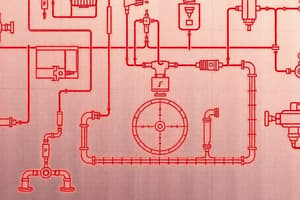Podcast
Questions and Answers
What is the primary purpose of a pneumatic tire?
What is the primary purpose of a pneumatic tire?
- To provide a cushioning effect and a smoother ride (correct)
- To provide better traction and grip
- To reduce the weight of the vehicle
- To increase the speed of the vehicle
Who is credited with the invention of the pneumatic tire?
Who is credited with the invention of the pneumatic tire?
- John Boyd Dunlop (correct)
- Nicolaus August Otto
- Leonardo da Vinci
- Henry Ford
What is the main fabric of the tire typically made of?
What is the main fabric of the tire typically made of?
- Aluminum
- Steel
- Rubber, polyester, or other materials (correct)
- Copper
What is the purpose of the sidewall of a pneumatic tire?
What is the purpose of the sidewall of a pneumatic tire?
What type of tire features cords that run perpendicular to the direction of travel?
What type of tire features cords that run perpendicular to the direction of travel?
What is a benefit of using pneumatic tires?
What is a benefit of using pneumatic tires?
Flashcards are hidden until you start studying
Study Notes
Definition and History
- A pneumatic tire is a type of tire that uses compressed air to inflate a flexible casing, providing a cushioning effect and allowing for a smoother ride.
- Invented by John Boyd Dunlop in 1888, the pneumatic tire revolutionized the bicycle industry and later became a standard component in the automotive industry.
Components
- Tire casing: The main fabric of the tire, typically made of rubber, polyester, or other materials.
- Inner tube: A separate, airtight bag inside the tire casing that holds the compressed air.
- Tread: The outer layer of the tire that comes into contact with the road, providing traction and grip.
- Sidewall: The part of the tire between the tread and the rim, providing additional strength and protection.
Types of Pneumatic Tires
- Radial tires: Feature cords that run perpendicular to the direction of travel, providing better traction and fuel efficiency.
- Bias tires: Feature cords that run at an angle to the direction of travel, providing better handling and stability.
- All-season tires: Designed to provide a balance of traction, durability, and fuel efficiency in various weather conditions.
- Specialty tires: Include snow tires, off-road tires, and high-performance tires, designed for specific uses and environments.
Benefits and Advantages
- Improved ride quality: Pneumatic tires provide a smoother ride and better shock absorption.
- Increased traction: The flexible casing and tread pattern provide better grip and handling on various road surfaces.
- Fuel efficiency: Pneumatic tires can improve fuel efficiency by reducing rolling resistance.
- Durability: Pneumatic tires are more resistant to wear and tear, providing a longer lifespan.
Studying That Suits You
Use AI to generate personalized quizzes and flashcards to suit your learning preferences.




